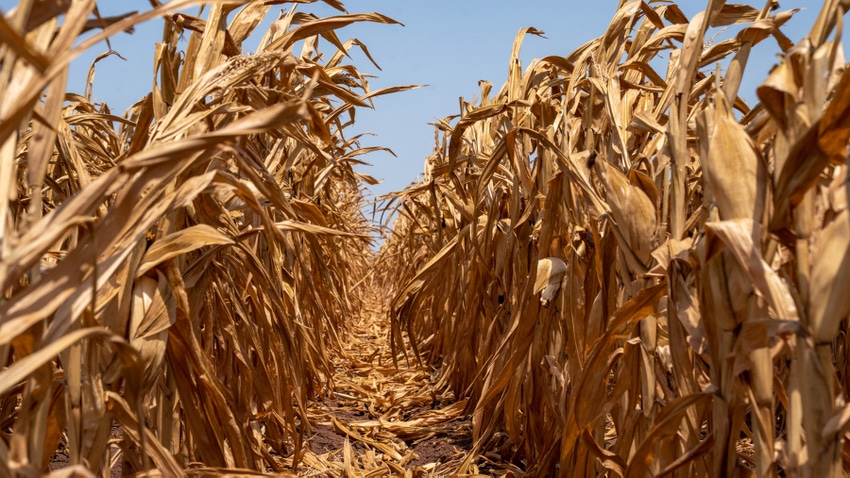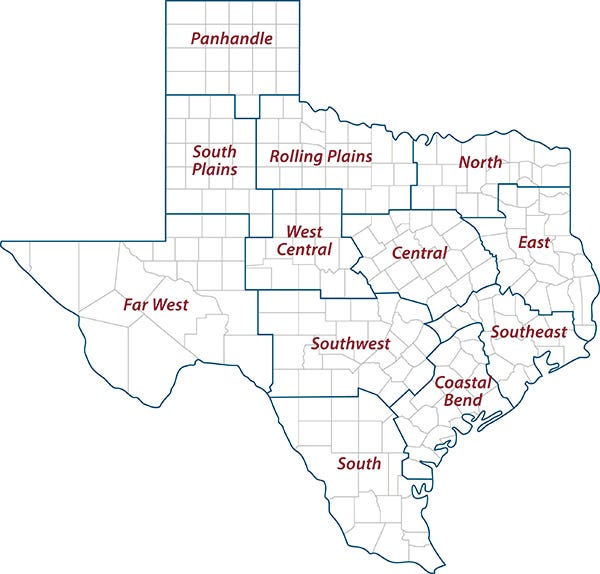August 31, 2023

Heat and drought have taken a toll on Texas crop production. Limited production of corn and sorghum and the unknown future have caused prices for those crops to spike, according to a Texas A&M AgriLife Extension Service expert.
Mark Welch, AgriLife Extension economist-grain marketing in the Texas A&M Department of Agricultural Economics, Bryan-College Station, said 2023 crop production for Texas summer-grown crops such as corn and sorghum is better than compared to 2022. However, dry conditions will still take a small toll on producers in certain areas for this year’s harvest.
2023 Summer Drought
Although much of the state had a decent late winter and early spring rainfall, the 2023 crop production has been “a mixed bag depending on location,” Welch said. The South Texas and Coastal Bend region experienced more rainfall during the early months of 2023, which allowed farmers to gain a head start in crop production.
Central Texas producers did not get the same rainfall as the southern region, which resulted in extreme heat this summer, stunting the growth of crops through sensitive stages.
Panhandle producers, especially corn producers, started irrigating crops during the early summer months. The extreme heat and high winds have made it difficult and expensive for irrigation systems to keep up. Though much is unknown until the completion of harvest in late September and early October, producers are preparing to experience extreme yield loss.
Change in prices
“This summer has been one of volatile and high variable prices,” Welch said.
The basis price, which is the difference between the local cash price and the future market price, for the feed grain markets has held firm throughout the summer, Welch said. And the drought affecting the nation’s Corn Belt has allowed Texas producers who were able to plant their crop in the early planting months, which resulted in good yields, to see a significant increase in prices.
Texas and other southern states have also experienced a spike in forage prices, such as hay and silage, due to the demand for forage from livestock owners and producers.
Welch said it will be late September or October before it is known what impact the continued heat and drought is having on 2023 production.
Also causing prices to spike is the war between Russia and Ukraine.
“We have come back down from last year’s pre-war prices, but there is still a big concern of grain prices and exports,” Welch said.
“Since the outbreak of the war, exports have continued with rising prices. The grain trade initiative has allowed some cargo vessels from Ukraine to export produce, but during the last few weeks, Russia has ended the grain trade initiative, and prices have spiked again. The bottom number will depend on what happens from now until the end of harvest,” Welch said.
AgriLife Extension district reporters compiled the following summaries:

CENTRAL
Drought conditions persisted with extremely hot and dry weather. Stock tank levels were steadily declining, major reservoirs drew down to critically low levels, and water restrictions became more widespread. Fire conditions persisted. A few localized, scattered showers dropped some rain but only helped lower daytime temperatures a few degrees. Heat continued to deteoriate forage, trees continued to burn, and woody brush turned yellow. The soil in pastures was cracking, and hay was being shipped in. Producers were unable to plow due to the low soil moisture. The cotton crop deteriorated near the point that additional rainfall will not help yields. Growers began seeking sources of winter cereals to plant when moisture conditions improve to establish grazing land this winter. Retailers expressed their expectations of seed shortages of both fall and winter rye and oats. Livestock producers switched supplemental feeding with little to no grazing left. Producers continued to sell and liquidate herds. The body condition scoring of cattle was thinning. The sale of steers dropped, cows were selling well, and the sale of heifers rose.
ROLLING PLAINS
Rolling Plains farmers and ranchers didn’t experience any relief for their land or livestock. Widespread drought continued with the prolonged extreme heat and lack of measurable moisture. The increased concern for fire conditions persisted. Water levels in livestock water tanks were edging dangerously low for producers, if not gone altogether.
COASTAL BEND
Widespread rainfall from a tropical system benefited much of the reporting area. However, it did little to offset drought. Matagorda County was declared a natural disaster area due to recent drought. The threat of wildfires was very high. Most row crop harvests were completed, apart from some cotton and rice. Most producers were working on stalk destruction of cotton and disking corn stalks. Triple-digit temperatures continued to deteriorate rangelands and pastures. Livestock markets remained strong, and large runs on cattle kept auctions busy. Many producers were trying to hang on to their cattle and were feeding hay and supplements. Hay was being transported, much of it coming as crop stubble out of the Rio Grande Valley and the rice-growing areas. Producers were keeping an eye on stock water sources.
EAST
Drought conditions persisted across the region. Wildfires became a problem in many areas. Producers who once thought they had a good stock of hay have started supplemental feeding their livestock. Producers were culling herds and selling calves early due to poor pasture conditions and water shortage. Cattle markets remained steady overall. Cherokee County reported that the local market stayed strong despite the higher-than-normal numbers sold.
SOUTH PLAINS
Rainfall may have occurred over the week in the South Plains region but was very sporadic. Most cotton fields hit cutout, 3.5 nodes above white flower, excluding those few where irrigation was high, as they could continued irrigation during the drought. Scouting of fields for insects was still needed. Crops were attacked by multiple pests such as Lygus and bollworms in cotton, Banks grass mites, corn earworms, mites in later corn fields and aphids were the primary issue in sorghum fields. A few acres were cut for silage, with more scheduled in the coming weeks.
PANHANDLE
Extreme hot and dry temperatures created heat and drought stress for all crops. Most crops were in the last quarter of crop production and development; therefore, most yields were set. The corn crop was persisting with pivots running. Much of the early corn was very close to harvest. Some of the fields with weak water were chopped on the edges to reduce field size. Livestock were in fair condition with supplemental feeding on a large scale.
NORTH
Temperatures remained extremely high and dry. The heat has led to stressed plants across the region. Some trees started to show significant drought stress, especially elms, honey locusts, maples and hackberry. Summer grasses were still declining. Many small creeks dried up entirely due to the extreme heat and no rainfall. Corn and grain sorghum were nearing harvest completion, and the soybean harvest was completed. Many bean fields were being rolled up for hay. Nuisance flies and tabanid flies were still active. Livestock conditions were good and continuing to improve.
FAR WEST
Daytime temperatures were in the low 90s, with overnight temperatures in the lower 70s. Isolated areas received 1.5-3 inches of rain. The heavy rain saturated the soil, causing producers to take a couple of days to get into the fields. Subsoil moisture had improved, varying from short to adequate. Although it was cooler this week, this season’s extreme heat had this cotton crop deteriorating. Bolls were beginning to open prematurely with immature seeds and lint inside. Other fields continued to shed bolls, some up to eight days old. All corn was harvested, and sorghum was nearly complete. Pecans were growing well, though the wind knocked many off the branches. Rainfall encouraged a small amount of reliance on rangelands and pastures. Livestock were in poor to fair condition. Ranchers continued to take their cattle to the sale barn. Livestock producers continued supplemental feeding for the animals they have kept.
WEST CENTRAL
Hot and dry weather conditions persisted. Although some parts of the district received rainfall over the weekend, the drought intensified and moved the district into exceptional drought. Farmers began field preparation to plant small grains. Pecan trees were showing drought stress and dropping nuts. Row crops were suffering from extreme heat and lack of moisture. Forage and hay crops were in poor condition with limited cutting and baling of hay. Ranchers continued supplemental feeding for the livestock they kept.
SOUTHEAST
The region experienced scattered rainfall, but not enough to improve the conditions of rangelands and pastures. Hay production was very low in bales per acre. Many farmers were harvesting rice straw. Pecan trees began shedding nuts, and irrigated cotton was holding firm while dryland cotton was struggling. Madison County allowed producers to contact U.S. Department of Agriculture-Farm Service Agency offices to apply for assistance. Dry conditions continued to drive cattle to the local market. Producers continued supplemental feeding and hauling water to the animals they kept. Available surface water was at 75% as bayous and creeks that have never been dry were extremely low, with cracks in some areas.
SOUTHWEST
Extreme heat conditions persisted for the week. Some areas reported spotty showers of rainfall, which was a relief from the record-breaking temperatures. Remnants of Tropical Storm Harold scattered between 1.25-2.5 inches throughout Kinney County. Cooler and more seasonal temperatures were experienced for a couple of days. Pastures were responding well to the recent rainfall. Sutton County reported spotty showers and less than half of an inch received. Production of most range plants stopped due to drought conditions, and rainfed ponds were mostly dried out. The expected pecan yield was low overall due to insufficient water supplementing irrigation. Caldwell County received no rain this week. Caldwell County and 24 other counties in Texas were declared to be under a state of emergency for severe drought. Cattle markets remained strong. Livestock were in fair condition. Supplemental feeding was necessary for most livestock producers.
SOUTH
The cotton crop was about 80% harvested in the district, with others still defoliating in hopes of harvesting in the next few weeks. The stalk destruction deadline was approaching quickly, with no extension being planned. Pastures continued to suffer due to the hot and dry conditions. Irrigation districts were reaching a critical point regarding water availability, with almost certain water restrictions to come soon. Forages in rangelands and pastures were beginning to improve. Rapid green-up was already noted, and most were hopeful there was still enough time this season to produce some grass. Beef cattle markets continued to run average volumes and reported solid prices for all classes of beef cattle. All corn and grain sorghum were harvested with very little cotton left in the field, and sunflower and sesame harvest had yet to start. Livestock managers hoped for enough green-up from rains to limit haying and reduce supplemental feeding. Farmers began preparing fields for the next planting season. Stock tanks were slightly replenished. Cotton harvest continued, and it looked to be 75% harvested. Sesame harvest also continued. Citrus, sugarcane and hay meadows continued to be irrigated. Wildlife were abundant and found near water sources.
Source: Texas A&M AgriLife Extension, AgriLife Today, Randi Williams
Read more about:
DroughtYou May Also Like




